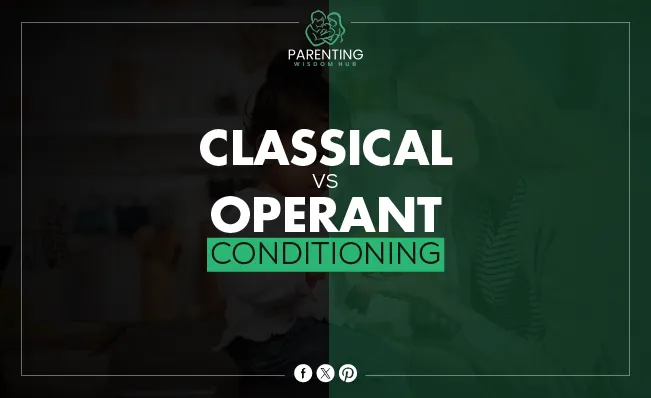Introduction
Have you ever wondered why your dog salivates when its food bowl rings or why the dentist’s drill makes you nervous? Psychological concepts like conditioning explain how behaviors are taught and repeated. This blog contrasts classical and operant conditioning, two fascinating conditioning strategies. We want to illustrate how these ideas differ, alter behavior, and affect many elements of life.
Readers will master classical and operant conditioning. We will explain essential concepts, describe processes, compare them, and discuss real-world applications in education, parenting, the workplace, and therapy. After reading this blog, you will understand human and animal behavior better.
What is Classical Conditioning?
Definition
Classical conditioning involves associating a neutral stimulus with a significant stimulus and learning to evoke a comparable reaction. Russian psychologist Ivan Pavlov proved this in his dog tests.
Key Concepts
- Unconditioned Stimulus (UCS): A stimulus here naturally and automatically triggers a reaction without learning beforehand. For instance, food is an unconditioned trigger since it makes dogs salivate naturally.
- Unconditioned Response (UCR): There is an innate reaction to an unconditioned stimulus called the unconditioned response. Based on Pavlov’s experiment, the unconditioned reaction is salivation when food is present.
- Conditioned Stimulus (CS): A stimulus that wasn’t conditioned before is paired with an unconditioned stimulus and causes a conditioned reaction. Pavlov’s experiment used the sound of a bell as the conditioned cue.
- Conditioned Response (CR): The reaction that was learned to the conditioned input. The trained response in Pavlov’s experiment is salivation, which happens when the bell rings without food being present.
Process
There are several steps in classical conditioning:
- Acquisition: In this learning step, the conditioned stimulus is paired with the unconditioned stimulus, which causes the conditioned response.
- Extinction: The conditioned reaction will slowly fade if the conditioned stimulus is shown repeatedly without the unconditioned stimulus.
- Spontaneous Recovery: The conditioned reaction may reappear but weaken when the conditioned stimulus is presented again after a break.
- Generalization: The tendency to react to things like the conditioned trigger. For example, a dog that has learned to salivate when it hears a bell may also drool when it hears a similar sound.
- Discrimination: Find the difference between a conditioned stimulus and other stimuli that don’t represent an unconditioned stimulus.
Examples
- Phobias: Classical conditioning can teach the fear of spiders or heights. A dog bite victim develops a fear of dogs through classical conditioning.
- Advertising: Advertisements use classical conditioning to elicit positive responses from consumers. Associating a soft drink with pleasant imagery can make customers like it.
What is Operant Conditioning?
Definition
One way people learn is through operant conditioning, in which the results of an action make it stronger or weaker. The psychologist B.F. Skinner researched this idea extensively, testing it on rats and pigeons.
Key Concepts
Reinforcement:
Positive Reinforcement: Adding a desirable stimulus increases the likelihood of an action happening again, such as giving a dog a treat for doing what you say, like sitting.
Negative Reinforcement: Eliminating an unpleasant stimulus makes an action more likely to happen again. One example is buckling up to silence the annoying beep in a car.
Punishment:
Positive Punishment: Adding an unpleasant stimulus to an action makes it less likely to happen again. One example is fined for going too fast.
Negative Punishment: Remove an excellent stimulus to make an action less likely to happen again. For instance, remove a child’s toy for being wrong.
Reinforcement Schedules:
- Fixed Ratio: After a certain number of answers, reinforcement is given. In this case, a free coffee after buying ten.
- Variable Ratio: After an unknown number of replies, reinforcement is given, like the slot machines in a casino.
- Fixed Interval: After a certain amount of time has passed, reinforcement is given. One example is getting paid every two weeks.
- Variable Interval: After an unknown amount of time, reinforcement is given, such as pop tests in the classroom.
Process
There are several steps to operant conditioning:
- Shaping: Until the goal behavior is reached, rewarding behaviors are getting closer and closer to what is wanted.
- Extinction: If you stop praising someone for a behavior, that behavior will worsen over time.
- Generalization: A learned behavior’s propensity to happen in reaction to similar stimuli and the original stimulus.
Examples
Training Pets: You can teach your dog to roll over by giving it a treat every time it does it right.
Behavior Management in Classrooms: Having a system where students can swap tokens for rewards based on how well they behave.
Differences between Classical vs. Operant Conditioning
Nature of Response
Classical Conditioning:
- Includes reflexive and automatic reactions that you can’t stop.
- Some examples are drooling when you see food or getting nervous when you hear a loud noise.
Operant Conditioning:
- It’s about actions people choose and are aware of controlling.
- For instance, this is an example of pushing a lever to get a prize or working hard to ensure you don’t fail a test.
Role of Stimuli
Classical Conditioning:
- A neutral stimulus becomes linked to an unconditioned signal when two stimuli are paired.
- The conditioned stimulus sets off a reaction like the unconditioned response.
Example: When food (UCS) is paired with a bell (CS), it makes people salivate (CR).
Operant Conditioning:
- It focuses on what happens after action, like rewarding or punishing those behaviors.
- The results of actions shape how people act.
Example: Rats learn that they get a food pellet (positive reward) when they press a lever.
Behavior Modification
Classical Conditioning:
- Behaviors are learned by linking stimuli together, which leads to automatic reactions.
- Behaviors need to keep pairing up with inputs to stay stable.
- When the conditioned reaction weakens because the conditioned stimulus is no longer present, this is called extinction.
Operant Conditioning:
- Behaviors are learned and kept up by looking at what happens after we do them.
- When you reward good behavior, it gets more robust; when you punish bad behavior, it gets weaker.
- When the reward for a behavior stops, the behavior decreases or stops altogether. This is called extinction.
Similarities between Classical vs. Operant Conditioning
Classical conditioning and operant conditioning are two different ways to learn, but they have some things in common:
Learning Process:
- Learning how to connect stimuli and reactions is a part of both.
- They both involve associative learning, which means that how someone acts is affected by the results of that behavior or by how it is linked to events.
Behavior Modification:
- People can change how they act through both classical and operant training.
- They can change, keep, or stop actions with the proper reinforcement or punishment.
Acquisition and Extinction:
- Acquisition (when behaviors are first learned) and extinction (when learned behaviors lessen over time when reinforcement is not present) are parts of both types of conditioning.
Generalization and Discrimination:
- Both things can cause generalization when learned reactions happen to similar stimuli that weren’t linked initially to the response.
- As people learn to tell the difference between similar inputs so they can only react to specific cues, this is called discrimination learning.
Real-World Applications:
- The ideas behind classical and operant conditioning are used in many real-life situations, such as teaching, therapy, advertising, and training animals.
- For practical reasons, both are used to understand and change how people and animals behave.
By noticing these connections, we can better understand how classical and operant conditioning help us learn and change our behavior in different situations.
Applications in Everyday Life
Education
- Positive Reinforcement in the Classroom: Teachers often praise, reward, or give extra recess for good behavior and academic performance. Positive reinforcement encourages excellent conduct and academic rigor by encouraging timely submissions or participation.
- Behavior Modification Plans: Teachers create Individualized Education Programs (IEPs) to reinforce positive behavior and reduce bad ones. These plans often use systematic reinforcement schedules suited to student needs.
- Interactive Learning Tools: Gamified educational software with rapid rewards and feedback can boost student engagement and motivation. Operant conditioning is used in educational apps that give students points or badges for learning new subjects.
- Classroom Management Techniques: Time out or loss of privileges are negative consequences for poor conduct. These tactics are monitored to promote a positive learning environment.
- Formative Assessments: Quizzes and other assessments help teachers reinforce learning and identify areas for improvement. This method uses fixed or variable interval reinforcement regimens based on assessment scheduling.
Educational settings use classical and operant conditioning to modify behavior, improve learning, and succeed academically.
Parenting
- Positive Reinforcement at Home: Parents employ verbal praise, prizes, and extra privileges to promote exemplary behavior. Praising a child for doing chores can encourage them to do them again.
- Implementing Consequences: Time-outs, privilege loss, and extra chores diminish lousy behavior. Applying these consequences consistently helps kids grasp how their actions affect their results.
- Establishing Routines: Consistent schedules and routines help youngsters grasp expectations and consequences. This provides them with security and predictability.
- Behavior Charts and Token Systems: These tools show and reinforce good conduct. For good behavior, kids get tokens or stickers they can trade for rewards.
- Modeling Behavior: Parents show their kids how to behave by doing what they want them to do. Children learn by watching and copying what their parents do and say.
- Social Skills Training: Parents teach sharing, empathy, and conflict resolution through role-playing and supervised practice. Positive reinforcement promotes the real-world use of these abilities.
These conditioning concepts can help parents modify their children’s behavior, encourage good habits, and create a supportive home.
Workplace
- Employee Recognition Programs: Many firms have employee appreciation programs that boost good performance. Bonuses, honors, and public recognition boost productivity and dedication.
- Performance-Based Incentives: Offering commissions, bonuses, or profit-sharing aligns employees with business goals. Operant conditioning reinforces high performance and goal achievement.
- Professional Development Opportunities: Career development opportunities, including training, seminars, and higher education, can reward initiative and high performance.
- Constructive Feedback: Regular, positive feedback helps employees assess their performance and develop. Positive feedback encourages good conduct, whereas negative feedback eliminates terrible behavior when appropriately utilized.
- Disciplinary Measures: Workplace rules often include disciplinary actions like written warnings, demotion, or firing as negative punishments to stop people from misbehaving.
- Goal Setting and Performance Reviews: Setting clear goals and regular performance reviews give workers feedback and performance standards. These can guide behavior and use both positive and negative rewards.
Companies can use these strategies to change employees’ behavior, boost productivity, and create a positive and inspiring workplace.
Therapy
- Behavioral Therapy: Uses operant and classical conditioning to change maladaptive behaviors. Exposure therapy and systematic desensitization are classical conditioning methods, while operant conditioning uses reinforcement.
- Cognitive-behavioral therapy (CBT): Addresses unhealthy beliefs and behaviors using behavioral and cognitive methods. Cognitive restructuring changes harmful thought patterns, while positive reinforcement promotes good behavior.
- Applied Behavior Analysis (ABA): This method, used with autistic children, reinforces positive behaviors and reduces negative ones. Following comprehensive behavioral observations, ABA therapists create tailored methods.
- Token Economy Systems: These systems use tokens to reward target actions in therapeutic contexts. Token exchange for rewards encourages improvement in good behavior.
- Biofeedback helps people control physiological processes with real-time input. As they regulate these processes, they receive positive reinforcement, improving their mental and physical health.
- Social Skills Training: It uses role-playing and feedback to teach social skills, especially to people with social anxiety or developmental disabilities. Positive reinforcement improves skill acquisition and utilization.
By applying these conditioning concepts, therapists can help clients change their behavior and improve their quality of life.
Criticisms and Limitations
Classical Conditioning
- Limited Scope: Limited to reflexive and automatic actions, classical conditioning emphasizes involuntary responses. More techniques are required for complicated voluntary activities.
- Generalization Issues: A conditioned reaction generalizing to similar stimuli might cause unintended connections and overgeneralization.
- Ethical Concerns: Animal-based classical conditioning research has generated ethical questions regarding the methods to obtain desired responses.
- Overemphasis on Associative Learning: According to critics, classical conditioning neglects cognitive processes in behavior modification in favor of associative learning mechanisms.
- Dependence on Environmental Cues: For classical conditioning to work, the world needs consistent and predictable cues, which may only sometimes be the case in real life.
Understanding these limits helps professionals determine whether classical conditioning techniques are appropriate for certain settings and address any issues that may occur.
Operant Conditioning
- The complexity of human behavior: Many factors impact people’s behaviors simultaneously, making it challenging to attribute behavior change to incentives or penalties.
- Over-Reliance on External Rewards: People who depend too much on outside rewards may lose their intrinsic drive, which makes them less likely to do things without rewards.
- Individual Differences: Because different people respond differently to the same punishments and benefits, it may take time and money to come up with unique methods.
- Behavioral Relapse: If you don’t keep praising behaviors that you’ve taught, they might not stick when the benefits stop coming in, which could cause you to return.
- Focus on Observable Behaviors: Operant conditioning doesn’t consider internal cognitive and mental processes, so it can’t help with deep psychological problems.
Final Thoughts
It is essential to understand both classical and operant training for both personal and professional growth. People can better understand their actions and those of others if they know the ideas behind these conditioning theories. This information can help you develop good ways to change people’s behavior, whether teaching, parenting, at work, or in therapy.


